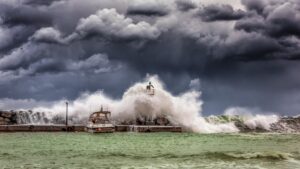 Being on a boat in a storm has to be one of the most terrifying things ever. You’re at the mercy of the weather and waves that reach at least as high as a few stories. One wrong twist of fate and your vessel will be at the bottom of the ocean–guaranteed. Not even the most experienced mariners can afford to underestimate such a situation and that’s a given.
Being on a boat in a storm has to be one of the most terrifying things ever. You’re at the mercy of the weather and waves that reach at least as high as a few stories. One wrong twist of fate and your vessel will be at the bottom of the ocean–guaranteed. Not even the most experienced mariners can afford to underestimate such a situation and that’s a given.
But what if you figure yourself in the middle of it? As a boat owner, you have to understand that getting your boat in a storm isn’t a matter of if, but when. This is especially true if you live and in an area prone to hurricanes, or if you set sail more frequently than a typical recreational boater.
Is your vessel prepared for the inevitable? Well, here are the things you must know for you to ensure that your boat survives a storm relatively scot-free.
Related: Safety First: Boat Handling Tips During Bad Weather
You Can Do Something To Avoid It, Mostly
Your boat will get in a storm one of these days, that’s for sure. But that also doesn’t mean you can’t do anything to avoid it. All you have to do is something simple and a bit boring: tracking weather reports. Take a closer look at the daily and weekly forecasts to plan your upcoming trip. That way, you can minimize your risks of getting your boat in a storm.
However, the keyword is “minimize.” You should know by now that weather reports aren’t 100 percent accurate. Mother Nature has her way of being unpredictable, and that’s part of your job to understand as a mariner! You can go out on the water confident that it won’t get ugly, and all of a sudden, you see and feel that a storm is coming. It happens.
The fact that you won’t see the squall coming is not weird. For instance, if you see an anvil-shaped cloud, it is often a sure sign of a storm. Temperatures will also tend to drop as much as 5 to 6 degrees shortly before a storm hits. These are the things that you have to watch out for. And if you start seeing these, it’s time to head back to port as fast as you can–assuming you still can.
Related: Under Which Conditions Do Most Boating Accidents Occur?
Preparing Your Boat To Withstand A Tempest
You’re lucky that you don’t have to sail wooden boats anymore, like those in the old days. Modern vessels are more durable and will be able to withstand a modicum of storms at sea. There are many things to watch out for, and these are several of the most important.
Lightning Strikes
Aside from the constant rain and high winds, lightning is also a clear danger.
So how do you protect your boat against lightning strikes? Understand how lightning works! It will always, always seek out the highest point of anything. On your boat, that will often be the top of your mast or the roof of the skipper’s bridge. Sometimes it can also be an antenna, or even the tallest person standing on the deck.
After hitting the high point, the bolt will find its way to water which is a conductor. So to minimize damage, try to stay inside an enclosed cabin and away from anything metal. This reduces your chances of getting shocked because the electricity might jump from any and all possible conductors until it reaches the water. Another protective measure will be to lower everything like antennas, towers, and outriggers to eliminate anything that lightning bolts can hit.
Here are a few more things: never grab any two metal objects in the event of a strike or near strike. Never use your VHF radio, unless you absolutely have to. And if you’re in a boat without any enclosed cabin, remove all your metal jewelry, drop anchor, put on a life jacket, and drop low to the center of the boat. Do this and you’ll minimize your chances of getting hit by a lightning strike.
 High Winds
High Winds
While there is a real chance of getting hit by lightning when your boat is stuck in a storm, your greatest adversary is still the high winds. To survive, strip off all of your canvas to drastically reduce windage. This includes everything from biminis, flags, pennants, dodgers, awnings, mainsails – literally anything made of fabric. Even the smallest open fabric will catch the wind, eventually destroying the whole cloth structure and any framework keeping it together. As soon as the wind speed reaches 60 knots, drop all of your fabric ASAP.
Heavy Rainfall
Lastly, you also have to deal with heavy rains. To prevent possible catastrophic water damage, secure all the hatches, ports, bow and stern lockers, cockpit lockers, and the anchor locker above all else. Cover any opening that could take in water like engine vents, engine space hatches, and companionway doors or slats, among others. You have to keep your boat as watertight as possible both above and below deck.
Here’s another idea: if you want to keep your boat truly watertight, get the most durable boat glass replacement you can find. We at Peninsula Glass can help with that! Any boat in a storm will fare far better if the windows can withstand a constant beating from the elements and keep water out.
If Moored/Anchored At Port
Even boats anchored at the port are not safe from a storm. As soon as you see all the signs of a coming squall, double or triple all attachment points to secure your vessel. If you can, tie your boat onto heavy fixed objects on land like bollards, pilings, and even trees. But one of the most important things is allowing slack. Taut ropes or chains will not have enough room to move around and will be more vulnerable to breaking.
